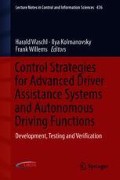Abstract
It is well known that the development of future automated driving faces big challenges regarding testing and validation. One strategy to tackle the drastically increased complex interaction of vehicle, driver, and environment is the so-called front-loading approach. This involves virtual development of new vehicle functions enabling early stage testing and validation. Within the funded project Technology Concepts for Advanced Highly Automated Driving (TECAHAD), this front-loading approach was applied for a concept development of an automated driving system (ADS)—the Motorway Chauffeur (MWC)—fully responsible for longitudinal and lateral motion of a car on motorways. In the following, we provide an insight on early stage virtual development of this ADS. Topics range from high-level requirements and functional safety investigations to software architecture and major components of the virtual implementation. Finally, first simulation results are shown for some MWC use cases, motivating the planned future real vehicle prototype implementation.
Access this chapter
Tax calculation will be finalised at checkout
Purchases are for personal use only
References
SAE International: Taxonomy and Definitions for Terms Related to On-Road Motor Vehicle Automated Driving Systems (2014). https://doi.org/10.4271/J3016_201401.
Winner, H.: ADAS, Quo Vadis, pp. 1557–1584. Springer International Publishing, Cham (2016)
ISO 22179:2009: Intelligent transport systems—Full speed range adaptive cruise control (FSRA) systems—Performance requirements and test procedures. Tech. rep., International Organization for Standardization (2009)
ISO 11270:2014: Intelligent transport systems—Lane keeping assistance systems (LKAS)—Performance requirements and test procedures. Tech. rep., International Organization for Standardization (2014)
ISO 17387:2008: Intelligent transport systems—Lane change decision aid systems (LCDAS)—Performance requirements and test procedures. Tech. rep., International Organization for Standardization (2008)
MATLAB: Version 7.14 (R2012a).: The MathWorks Inc., Natick, Massachusetts (2012)
IPG Automotive GmbH.: CarMaker 4.0. Karlsruhe, Germany (2012)
Neubauer, L.: Absolute Position Estimation with GPS/INS Sensor Fusion
Riekert, P., Schunck, T.: Zur Fahrmechanik des gummibereiften Kraftfahrzeugs. Ingenieur-Archiv 11, 210–224 (1940). https://doi.org/10.1007/BF02086921
Kosecka, J., Blasi, R., Taylor, C., Malik, J.: A comparative study of vision-based lateral control strategies for autonomous highway driving. In: Proceedings of IEEE International Conference on Robotics and Automation, 1998, vol. 3, pp. 1903–1908 (1998)
Nestlinger, G., Stolz, M.: Bumpless transfer for convenient lateral car control handover. IFAC-PapersOnLine 49(15), 132–138 (2016). In: 9th IFAC Symposium on Intelligent Autonomous Vehicles IAV 2016, Leipzig, Germany, 29 June–1 July 2016
ISO/DIS 26262-1—Road Vehicles Functional Safety Part 1 Glossary. Tech. rep., Geneva, Switzerland (2009)
Martin, H., Tschabuschnig, K., Bridal, O., Watzenig, D.: Functional Safety of Automated Driving Systems: Does ISO 26262 Meet the Challenges, pp. 387–416. Springer International Publishing, Cham (2017)
Stüker, D.: Heterogene Sensordatenfusion zur robusten Objektverfolgung im automobilen Straßenverkehr. P.h.d. Thesis, Carl von Ossietzky-Universität Oldenburg (2004)
Urmson, C., Anhalt, J., Bae, H., Bagnell, J., Baker, C., Bittner, R., Brown, T., Clark, M.N., Darms, M., Demitrish, D., Dolan, J., Duggins, D., Ferguson, D., Galatali, T., Geyer, C., Gittleman, M., Harbaugh, S., Hebert, M., Howard, T., Kolski, S., Likhachev, M., Litkouhi, B., Kelly, A., McNaughton, M., Miller, N., Nickolaou, J., Peterson, K., Pilnick, B., Rajkumar, R., Rybski, P., Sadekar, V., Salesky, B., Seo, Y., Singh, S., Snider, J., Struble, J., Stentz, A., Taylor, M., Whittaker, W., Wolkowicki, Z., Zhang, W., Ziglar, J.: Autonomous driving in urban environments: boss and the urban challenge. J. Field Robot. (Special Issue on the 2007 DARPA Urban Challenge, Part I) 25(8), 425–466 (2008)
Hult, R., Tabar, R.S.: Path Planning for Highly Automated Vehicles. Mathesis, Gothenburg (2013)
Werling, M., Groll, L., Bretthauer, G.: Invariant trajectory tracking with a full-size autonomous road vehicle. IEEE Trans. Robot. 26(4), 758–765 (2010)
Li, X., Sun, Z., Zhu, Q., Liu, D.: A unified approach to local trajectory planning and control for autonomous driving along a reference path. In: 2014 IEEE International Conference on Mechatronics and Automation (ICMA), pp. 1716–1721 (2014)
Zhang, S., Deng, W., Zhao, Q., Sun, H., Litkouhi, B.: Dynamic trajectory planning for vehicle autonomous driving. In: 2013 IEEE International Conference on Systems, Man, and Cybernetics (SMC), pp. 4161–4166 (2013). https://doi.org/10.1109/SMC.2013.709
Rupp, A., Stolz, M.: Eine erweitere bewertungsfunktion fr umfassende trajektorienplanung auf autobahnen. pp. 337–356. VDI Verlag GMBH, Deutschland (2016)
Schramm, D., Hiller, M., Bardini, R.: Single Track Models, pp. 223–253. Springer Berlin Heidelberg, Berlin, Heidelberg (2014)
Acknowledgements
The publication was written at VIRTUAL VEHICLE Research Center in Graz, Austria. The authors would like to acknowledge the financial support of the COMET-K2—Competence Centers for Excellent Technologies Programme of the Federal Ministry for Transport, Innovation and Technology (bmvit), the Federal Ministry for Digital, Business and Enterprise (bmdw), the Austrian Research Promotion Agency (FFG), the Province of Styria and the Styrian Business Promotion Agency (SFG).
They would furthermore like to express their thanks to their supporting industrial and scientific project partners, namely AVL List GmbH, MAGNA STEYR Engineering AG & Co KG and to the Institute of Automation and Control at the Technical University of Graz.
Author information
Authors and Affiliations
Corresponding author
Editor information
Editors and Affiliations
Rights and permissions
Copyright information
© 2019 Springer International Publishing AG, part of Springer Nature
About this chapter
Cite this chapter
Nestlinger, G. et al. (2019). Virtual Concept Development on the Example of a Motorway Chauffeur. In: Waschl, H., Kolmanovsky, I., Willems, F. (eds) Control Strategies for Advanced Driver Assistance Systems and Autonomous Driving Functions . Lecture Notes in Control and Information Sciences, vol 476. Springer, Cham. https://doi.org/10.1007/978-3-319-91569-2_8
Download citation
DOI: https://doi.org/10.1007/978-3-319-91569-2_8
Published:
Publisher Name: Springer, Cham
Print ISBN: 978-3-319-91568-5
Online ISBN: 978-3-319-91569-2
eBook Packages: Intelligent Technologies and RoboticsIntelligent Technologies and Robotics (R0)

